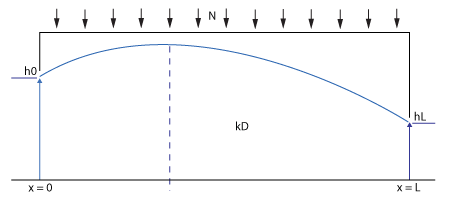Freatic groundwater levels benchmark (Water Module): Difference between revisions
(→Setup) |
(→Setup) |
||
| Line 27: | Line 27: | ||
The simulation time is set to 365 days. | The simulation time is set to 365 days. | ||
Rain set is set to | Rain set is set to <math>[3600 \cdot 24 \cdot 365, \frac{0.8}{3600 \cdot 24}]</math> | ||
===Results=== | ===Results=== | ||
Revision as of 16:56, 14 December 2020
This testcase simulates a situation where a parcel of land is situated between two waterways, each with a stable but different water level. In combination with continuous rainfall, a characteristic curve will form over time, as shown in the image below.
Formulas
Due to continuous rainfall and two stable water levels left and right, a specific ground water table curve will form. Part of the rainwater will flow left and part of the it will flow right. Note that the time at which this balance occurs is dependent on the starting situation.
The following formula [1] describes the curve when the ground water levels have become stable:
where:
- : distance of the left waterway edge (m)
- : water level at x = 0 (m)
- : water level at x = L (m)
- : distance between both waterways (m)
- : horizontal infiltration speed (m / day)
- : additional ground water (m/day). Note that this is the amount of rain divided by the freatic storage capacity.
Setup
The following setup has been taken from grondwaterformules.nl The Length L is 500 m. This is achieved with a grid size of 28 by 5, with a cell size of 20 m. On cell x = 1 and x = 26 an underground inlet is placed to keep the ground water level stable.
The terrain height is set to 12.
For x = 1 the initial ground water level is set to 11 and for x = 26 the ground water level is set to 10. The initial ground water levels between this points is interpolated.
The simulation time is set to 365 days. Rain set is set to
Results
References
- ↑ Bear, J., 1979. Hydraulics of Groundwater. McGraw-Hill. (formula on p.180, equation 5-212)








![{\displaystyle [3600\cdot 24\cdot 365,{\frac {0.8}{3600\cdot 24}}]}](https://wikimedia.org/api/rest_v1/media/math/render/svg/5c950e3f70d3b13985818381302209257d587810)




